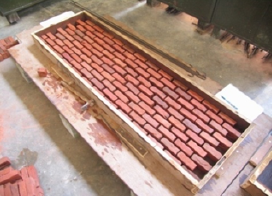1 Professor, Department of Civil Engineering, Indian Institute of Technology Kanpur, Kanpur, India, dcrai@iitk.ac.in
2 Former Graduate Student, Department of Civil Engineering, Indian Institute of Technology Kanpur, Kanpur, India, nishits@iitk.ac.in
ABSTRACT
Reinforced brick (RB) masonry slab is widely used for floor and roof diaphragms throughout northern India from 1920’s to until recently. Currently such construction is still popular in rural areas because of its easily available materials, low cost and lesser skilled labour requirement. Increasing cases of deterioration of such existing slabs and the need for their retrofitting has renewed the interest in the study of its behavior. Four, half-scale one-way slabs of clear span of 1500 mm and 500 mm wide and two, two-way square slabs of 1500 mm clear span were casted and loaded up to failure. The one-way slabs were loaded as three-span (4-point) flexure loading, while, the two-way slabs were loaded centrally by a patch loading. The load carrying capacity of these slabs was compared with simple sectional analyses.
Working Stress and Limit State Methods were used to obtain the allowable and ultimate moment capacity of the RB slab section, respectively. The yield line theory was used to predict the load capacity of the two-way slabs based on their collapse mechanism. The working stress approach provided conservative estimates of moment and load capacities, which was about 0.42 times the experimental observed capacity. On the other hand, various formulations based on limit state approach provided estimates in the range of 62% to 89% of the experimental load capacity for one-way and two-way slabs.
KEYWORDS: reinforced brick slabs, masonry, flexural strength, FE analysis
465.pdf



